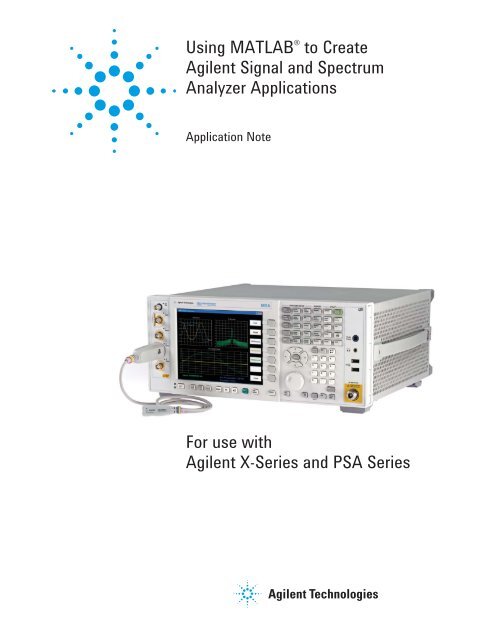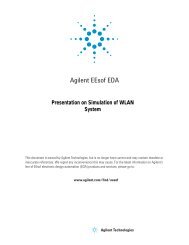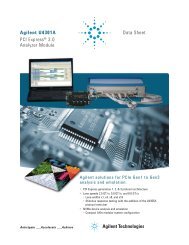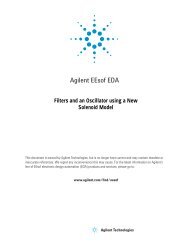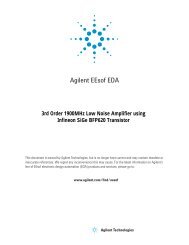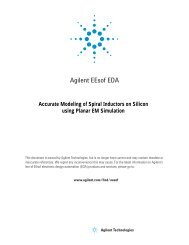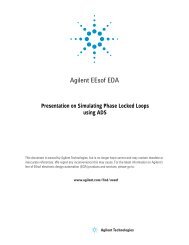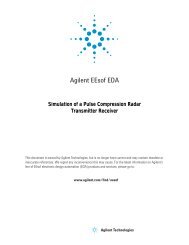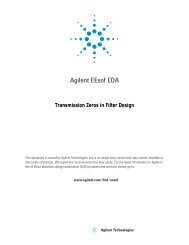Using MATLAB® to Create Agilent Signal and Spectrum Analyzer ...
Using MATLAB® to Create Agilent Signal and Spectrum Analyzer ...
Using MATLAB® to Create Agilent Signal and Spectrum Analyzer ...
Create successful ePaper yourself
Turn your PDF publications into a flip-book with our unique Google optimized e-Paper software.
<strong>Using</strong> MATLAB ®<br />
<strong>to</strong> <strong>Create</strong><br />
<strong>Agilent</strong> <strong>Signal</strong> <strong>and</strong> <strong>Spectrum</strong><br />
<strong>Analyzer</strong> Applications<br />
Application Note<br />
For use with<br />
<strong>Agilent</strong> X-Series <strong>and</strong> PSA Series
1.0 Introduction ..................................................................................................... 3<br />
1.1 Overview of <strong>Agilent</strong> signal <strong>and</strong> spectrum analyzers ......................... 3<br />
1.2 <strong>Agilent</strong> offers MATLAB software for <strong>Agilent</strong> instruments ............... 4<br />
2.0 Controlling Instruments in MATLAB using Interface Objects,<br />
Device Objects, <strong>and</strong> Instrument Drivers .................................................... 5<br />
2.1 Controlling instruments in MATLAB using interface objects ................. 5<br />
2.2 Creating a MATLAB Instrument Driver ................................................ 6<br />
2.3 Controlling Instruments in MATLAB <strong>Using</strong> Device Objects ..........16<br />
3.0 Creating, Modifying, <strong>and</strong> Executing X-Series <strong>and</strong> PSA Applications<br />
using MATLAB Software ............................................................................30<br />
3.1 Application example #1: Analog signal demodulation ...................30<br />
3.2 Application example #2: Advanced data visualization ...................32<br />
3.3 Application example #3: Tune <strong>and</strong> listen ..........................................34<br />
Summary ...............................................................................................................34<br />
Appendix – Additional Examples .....................................................................35<br />
2
1.0 Introduction<br />
<strong>Agilent</strong> X-Series signal <strong>and</strong> spectrum analyzers are built based on the Microsoft ®<br />
Windows ® operating system. Integrating this operating system in<strong>to</strong> <strong>Agilent</strong> instruments<br />
enables users <strong>to</strong> interface these instruments <strong>to</strong> application software<br />
using industry-st<strong>and</strong>ard connectivity (LAN, USB, <strong>and</strong> GPIB), <strong>and</strong> develop <strong>and</strong><br />
execute their own applications for the <strong>Agilent</strong> X-Series signal <strong>and</strong> spectrum analyzers<br />
using MATLAB software.<br />
In the following application note, we discuss <strong>and</strong> demonstrate basic instrument<br />
communication using MATLAB code. We progress <strong>to</strong> more application-specifi c<br />
MATLAB code examples <strong>and</strong> then describe how you can start developing your<br />
own MATLAB-based applications integrated in<strong>to</strong> the X-series signal <strong>and</strong> spectrum<br />
analyzers by referencing existing examples that you can download <strong>and</strong><br />
modify.<br />
This application note explains how <strong>to</strong> use MATLAB software <strong>to</strong> confi gure, control,<br />
<strong>and</strong> acquire data from X-Series signal <strong>and</strong> spectrum analyzers. The document<br />
then describes how you can use scripts developed in MATLAB <strong>to</strong> create,<br />
modifi y, <strong>and</strong> execute your own applications for X-Series signal <strong>and</strong> spectrum<br />
analyzers. You can also use many of the MATLAB examples in this application<br />
note with PSA high performance analyzers.<br />
Finally, this application note provides references <strong>to</strong> on-line resources where you<br />
can download previously-developed MATLAB applications, which can be executed<br />
on your instrument directly or modifi ed <strong>to</strong> suite your specifi c testing needs.<br />
This application note aims <strong>to</strong> enhance your knowledge of using MATLAB with<br />
<strong>Agilent</strong> signal <strong>and</strong> spectrum analyzers. To learn more about getting started with<br />
MATLAB, users may also wish <strong>to</strong> refer <strong>to</strong> MATLAB’s on-line documentation.<br />
1.1 Overview of <strong>Agilent</strong> signal <strong>and</strong> spectrum analyzers<br />
From DC <strong>to</strong> 325 GHz, <strong>Agilent</strong> Technologies offers X-Series <strong>and</strong> PSA signal <strong>and</strong><br />
spectrum analyzers that enable you <strong>to</strong> analyze dis<strong>to</strong>rtion, spurious, phase noise,<br />
<strong>and</strong> make 2G <strong>to</strong> 4G wireless communication measurements.<br />
• The low-cost CXA is a versatile <strong>to</strong>ol for essential signal characterization.<br />
• The economy-class EXA is the fastest way <strong>to</strong> maximize throughput on the<br />
production line.<br />
• The mid-performance MXA is the ultimate accelera<strong>to</strong>r as your products move<br />
from design <strong>to</strong> manufacturing <strong>to</strong> the marketplace.<br />
• The high-performance PXA is the evolutionary replacement for your current<br />
performance signal analyzer.<br />
3
1.2 <strong>Agilent</strong> offers MATLAB software for<br />
<strong>Agilent</strong> instruments<br />
MATLAB is used <strong>to</strong> create, develop, <strong>and</strong> execute X-Series applications. MATLAB<br />
is also used with <strong>Agilent</strong> instruments, including signal <strong>and</strong> spectrum analyzers<br />
<strong>to</strong> make measurements, analyze <strong>and</strong> visualize data, generate arbitrary waveforms,<br />
control instruments, execute modulation schemes, <strong>and</strong> build test systems.<br />
MATLAB provides interactive <strong>to</strong>ols <strong>and</strong> comm<strong>and</strong>-line functions for data<br />
analysis tasks such as signal processing, signal modulation, digital filtering, <strong>and</strong><br />
curve fitting.<br />
MATLAB excels at math <strong>and</strong> matrix processing, can be used for communications<br />
DSP, <strong>and</strong> offers outst<strong>and</strong>ing plotting <strong>and</strong> graphics functions. MATLAB makes an<br />
excellent companion program <strong>to</strong> the X-Series or PSA, whether running remotely<br />
on an external PC, or running directly inside the instrument. Under the control<br />
of MATLAB, the signal analyzer can acquire RF or microwave signals. These<br />
acquisitions can be scalar (magnitude-only versus frequency or time) or complex<br />
(magnitude <strong>and</strong> phase.) After transferring the data in<strong>to</strong> MATLAB, a user-defined<br />
program can be used for fuctions such as further analysis, testing, <strong>and</strong> au<strong>to</strong>matic<br />
test equipment (ATE) control.<br />
In order <strong>to</strong> provide complete test <strong>and</strong> measurement solutions, <strong>Agilent</strong> now<br />
sells three different MATLAB software packages, which are available with the<br />
purchase of X-Series <strong>and</strong> PSA signal <strong>and</strong> spectrum analyzers. Each package<br />
contains MATLAB <strong>and</strong> various libraries called “<strong>to</strong>olboxes” <strong>to</strong> add functionality<br />
for specific fields. The MATLAB - Basic <strong>Signal</strong> Analysis Package (N6171A-M01)<br />
provides MATLAB <strong>and</strong> the Instrument Control Toolbox, which are required for instrument<br />
interaction in MATLAB. The MATLAB - St<strong>and</strong>ard <strong>Signal</strong> Analysis Package<br />
(N6171A-M02) includes the products in the MATLAB - Basic <strong>Signal</strong> Analysis<br />
Package plus the Communications Toolbox <strong>and</strong> <strong>Signal</strong> Processing Toolbox. The<br />
MATLAB - Advanced <strong>Signal</strong> Analysis Package (N6171A-M03) includes the products<br />
in the MATLAB - St<strong>and</strong>ard <strong>Signal</strong> Analysis Package plus the Filter Design<br />
Toolbox <strong>and</strong> RF Toolbox. To learn more about the typical uses of each package<br />
visit www.agilent.com/find/n6171a.<br />
Please note that the examples provided in this application note require the products<br />
in the MATLAB - St<strong>and</strong>ard <strong>Signal</strong> Analysis Package <strong>to</strong> run. (Inform your<br />
<strong>Agilent</strong> account manager if you need a trial of MATLAB software.) However,<br />
other <strong>to</strong>olboxes can be very useful for data analysis <strong>and</strong> signal processing, such<br />
as the Communications Toolbox <strong>and</strong> RF Toolbox.<br />
4
2.0 Controlling<br />
Instruments in<br />
MATLAB using<br />
Interface Objects,<br />
Device Objects,<br />
<strong>and</strong> Instrument<br />
Drivers<br />
MATLAB’s Instrument Control Toolbox provides two different types of functions<br />
for interfacing with <strong>Agilent</strong>’s signal <strong>and</strong> spectrum analyzers. I/O communication<br />
is made simple with the use of MATLAB’s interface objects <strong>and</strong> device objects.<br />
An interface object allows the user <strong>to</strong> communicate with an instrument directly<br />
using a st<strong>and</strong>ard interface such as GPIB, TCP/IP, or VISA. A device object<br />
allows the user <strong>to</strong> communicate with an instrument at a higher level through an<br />
industry-st<strong>and</strong>ard instrument driver, such as an IVI-COM, IVI-C, or a selfdeveloped<br />
instrument driver. The driver itself then uses the GPIB, TCP/IP, or<br />
VISA interface. The Instrument Control Toolbox also provides <strong>to</strong>ols for developing<br />
MATLAB instrument drivers.<br />
2.1 Controlling instruments in MATLAB<br />
using interface objects<br />
The Instrument Control Toolbox provides several interface objects, but this section<br />
will focus on the GPIB, TCP/IP, <strong>and</strong> VISA interfaces. There are three basic<br />
steps <strong>to</strong> follow when using an interface object:<br />
1) Open an instrument control session.<br />
2) Connect <strong>to</strong> the instrument.<br />
3) When fi nished, disconnect the instrument interface object.<br />
The following is an example of how <strong>to</strong> communicate with an instrument using a<br />
General Purpose Interface Bus (GPIB) interface object.<br />
1) Open the instrument control session.<br />
GPIB_object = gpib(‘vendor’, boardindex, primaryaddress);<br />
If you were <strong>to</strong> use an <strong>Agilent</strong> 82357A USB <strong>to</strong> GPIB connec<strong>to</strong>r, then the statement<br />
might look like:<br />
MXA = gpib(‘agilent’, 7, 18);<br />
2) Connect <strong>to</strong> the instrument.<br />
fopen(MXA);<br />
3) Communicate with the instrument.<br />
identity = query(MXA, ‘*IDN?’)<br />
This will return the vendor, model number, serial number, <strong>and</strong> fi rmware revision<br />
of the instrument.<br />
4) When fi nished, disconnect the instrument object.<br />
fclose(MXA);<br />
It is also a good idea <strong>to</strong> clear the object from the memory by using the delete()<br />
comm<strong>and</strong>.<br />
delete(MXA);<br />
5
The same basic steps are followed when using a Transmission Control Pro<strong>to</strong>col/<br />
Internet Pro<strong>to</strong>col (TCP/IP) interface object.<br />
1) Open the instrument control session.<br />
TCPIP_object = tcpip(‘rhost’, rport);<br />
If you were <strong>to</strong> use an IP address of ’10.10.10.10’ <strong>and</strong> the port 5025, the comm<strong>and</strong><br />
would look like:<br />
mxa_ip = ‘10.10.10.10’;<br />
mxa_port = 5025;<br />
mxa = tcpip(mxa_ip,mxa_port);<br />
2) Connect <strong>to</strong> the instrument.<br />
fopen(MXA);<br />
3) Communicate with the instrument.<br />
identity = query(MXA, ‘*IDN?’)<br />
This will return the vendor, model number, serial number, <strong>and</strong> fi rmware revision<br />
of the instrument.<br />
4) When fi nished, disconnect the instrument object <strong>and</strong> delete it from memory.<br />
fclose(MXA);<br />
delete(MXA);<br />
Again, the same steps are followed <strong>to</strong> create a virtual instrument st<strong>and</strong>ard architecture<br />
(VISA) interface object.<br />
1) Open the instrument control session.<br />
VISA_object = visa(‘vendor’,’rsrcname’);<br />
If we are using the <strong>Agilent</strong> N9020A X-Series signal <strong>and</strong> spectrum analyzer, then<br />
we could use the following comm<strong>and</strong>:<br />
vendor = ‘agilent’;<br />
rsrcname = ‘TCPIP0::10.10.10.10::inst0::INSTR’;<br />
MXA = visa(vendor,rsrcname);<br />
There are two ways <strong>to</strong> fi nd out the resource name, if it is unknown. The fi rst way<br />
is <strong>to</strong> use the <strong>Agilent</strong> Connection Expert (ACE). This program is included in version<br />
15.0 or later of <strong>Agilent</strong>’s IO Library Suite (available at www.agilent.com/<br />
fi nd/iolib). To fi nd the name in the ACE look at the address in the ( ) next <strong>to</strong> the<br />
model number. This is the resource name, which is also called the VISA address.<br />
The other way <strong>to</strong> fi nd out the VISA address is <strong>to</strong> use the instrhwinfo() comm<strong>and</strong><br />
provided by the Instrument Control Toolbox. In this case, you would type info =<br />
instrhwinfo(‘visa’,’agilent’) in the MATLAB comm<strong>and</strong> window. This comm<strong>and</strong><br />
will return a structure with a fi eld named ObjectConstruc<strong>to</strong>rName.<br />
info =<br />
6
Adap<strong>to</strong>rDllName: [1x92 char]<br />
Adap<strong>to</strong>rDllVersion: ‘Version 2.6.0’<br />
Adap<strong>to</strong>rName: ‘AGILENT’<br />
AvailableChassis: []<br />
AvailableSerialPorts: ‘’<br />
InstalledBoardIds: 0<br />
ObjectConstruc<strong>to</strong>rName: {3x1 cell}<br />
SerialPorts: ‘’<br />
VendorDllName: ‘agvisa32.dll’<br />
VendorDriverDescription: ‘<strong>Agilent</strong> Technologies VISA Driver’<br />
VendorDriverVersion: 1<br />
To look at the contents of this fi eld, you would type info.ObjectConstruc<strong>to</strong>rName<br />
in the MATLAB comm<strong>and</strong> window. This will return a list of VISA addresses that<br />
are recognized by MATLAB. This list is directly connected <strong>to</strong> the instruments<br />
that are found in the ACE.<br />
info.ObjectConstruc<strong>to</strong>rName<br />
ans =<br />
‘visa(‘agilent’, ‘TCPIP0::141.121.94.85::inst0::INSTR’);’<br />
‘visa(‘agilent’, ‘GPIB0::12::INSTR’);’<br />
‘visa(‘agilent’, ‘GPIB0::18::INSTR’);’<br />
2) Connect <strong>to</strong> the instrument.<br />
fopen(MXA);<br />
3) Communicate with the instrument.<br />
identity = query(MXA, ‘*IDN?’)<br />
This will return the vendor, model number, serial number, <strong>and</strong> fi rmware revision<br />
of the instrument.<br />
4) When fi nished, disconnect the instrument object <strong>and</strong> delete it from memory.<br />
fclose(MXA);<br />
delete(MXA);<br />
7
2.1.1 An example MATLAB program<br />
using interface objects<br />
The following example shows the basic MXA communication procedure using<br />
functions of the Instrument Control Toolbox. This program Basic_SCPI_<br />
Control.m uses TCP/IP (LAN) connectivity <strong>to</strong> the instrument as it is one of the<br />
most widely used interfaces, <strong>and</strong> TCP/IP included in the MXA as a st<strong>and</strong>ard<br />
interface.<br />
% TCPIP parameters of the <strong>Spectrum</strong> <strong>Analyzer</strong><br />
mxa_ip = ‘10.10.10.10’;<br />
mxa_port = 5025;<br />
% MXA Interface creation <strong>and</strong> connection opening<br />
fprintf(‘\nConnecting <strong>to</strong> Instrument ...\n’);<br />
mxa = tcpip(mxa_ip,mxa_port);<br />
fopen(mxa);<br />
% Intrument identifi cation<br />
idn = query(mxa,’*IDN?’);<br />
fprintf(‘Hello from %s’, idn);<br />
% Set the center frequency <strong>to</strong> 1 GHz using a SCPI comm<strong>and</strong><br />
fprintf(mxa,’:FREQ:CENT 1 GHz’);<br />
% Set the span <strong>to</strong> 20 MHz<br />
fprintf(mxa,’:FREQ:SPAN 20 MHz’);<br />
% Set the reference level <strong>to</strong> +10 dBm<br />
fprintf(mxa,’:DISP:WIND:TRAC:Y:RLEV 10’);<br />
% Query the resolution b<strong>and</strong>width using fprinf()/fgets()<br />
fprintf(mxa,’:BAND:RES?’);<br />
rbw = str2double(fgets(mxa));<br />
fprintf(‘Resolution b<strong>and</strong>width: %d kHz\n’, rbw/1e3);<br />
% Query the sweep time using query()<br />
swp = str2double(query(mxa,’:SWE:TIME?’));<br />
fprintf(‘Sweep time: %d ms\n’, round(swp*1000));<br />
% Close the XA connection <strong>and</strong> clean up<br />
fprintf(‘Disconnecting from Instrument ...\n’);<br />
fclose(mxa);<br />
delete(mxa); % delete the interface object<br />
clear mxa; % clear from the workspace<br />
This program begins by defi ning the IP address <strong>and</strong> I/O port of the instrument,<br />
creating a TCP/IP interface <strong>and</strong> opening the interface for instrument communication.<br />
To fi nd the IP address of a particular MXA, press the following keys [System]<br />
{Show} {System}. In this example, the TCP/IP interface is the variable mxa.<br />
8
As shown in the previous section, the fopen(mxa) statement is used <strong>to</strong> open<br />
communication <strong>to</strong> the instrument. The fprintf() function is used <strong>to</strong> send SCPI<br />
comm<strong>and</strong>s <strong>to</strong> the instrument via the TCP/IP interface. This example sends the<br />
SCPI comm<strong>and</strong>s <strong>to</strong> set the center frequency, span, <strong>and</strong> reference level of the<br />
instrument.<br />
Instrument parameters <strong>and</strong> data can be queried from the instrument using many<br />
different MATLAB functions. This example uses two different methods. The<br />
method used <strong>to</strong> query the resolution b<strong>and</strong>width of the instrument is a combination<br />
of the fprintf() <strong>and</strong> fgets() comm<strong>and</strong>s. The fprintf(mxa,’:BAND:RES?’);<br />
comm<strong>and</strong> uses an SCPI comm<strong>and</strong> <strong>to</strong> place the value of resolution b<strong>and</strong>width in<br />
the output buffer <strong>and</strong> the fgets(mxa) comm<strong>and</strong> <strong>to</strong> read the data from the output<br />
buffer. The second method this example uses is the query() function. The<br />
query() function is essentially a combination of the fprintf() <strong>and</strong> fgets() functions.<br />
This example uses the query(mxa,’*IDN?’); function <strong>to</strong> retrieve information<br />
about the instrument’s serial number, model number, <strong>and</strong> fi rmware revision.<br />
This program concludes by closing the TCP/IP interface using the fclose(mxa);<br />
comm<strong>and</strong> <strong>and</strong> deleting the mxa variable from the workspace memory using the<br />
delete(mxa); <strong>and</strong> clear mxa; comm<strong>and</strong>s.<br />
The instrhelp comm<strong>and</strong> provides help on all the Instrument Control Toolbox<br />
functions <strong>and</strong> object properties. For example, typing instrhelp tcpip in the MAT-<br />
LAB comm<strong>and</strong> window displays the help text of the tcpip() function <strong>and</strong> lists all<br />
the properties of TCP/IP objects. Please refer <strong>to</strong> Product Help in MATLAB for a<br />
more detailed description of the Instrument Control Toolbox <strong>and</strong> its features.<br />
9
2.1.2 A second example MATLAB program using<br />
interface objects<br />
Acquiring trace data in spectrum analysis mode is one of the most common use<br />
cases when interacting with the instrument. The MATLAB script Acquire Trace<br />
Single.m demonstrates how a single trace can be acquired <strong>and</strong> plotted on a<br />
fi gure.<br />
% Getting <strong>and</strong> plotting trace data<br />
% Single trace acquisition<br />
% Initial setup<br />
mxa_ip = ‘10.10.10.10’;<br />
mxa_port = 5025;<br />
mxa=tcpip(mxa_ip, 5025);<br />
% input buffer size <strong>to</strong> receive trace data<br />
% should be at least 4 times the number of trace<br />
% points for 32-bit real format<br />
set(mxa,’InputBufferSize’,100000);<br />
fopen(mxa);<br />
% Set the data trace format <strong>to</strong> REAL, 32 bits<br />
fprintf(mxa,’:FORM:DATA REAL,32’);<br />
% Get the nr of trace points<br />
nr_points = str2double(query(mxa,’:SWE:POIN?’));<br />
% Get the reference level<br />
ref_lev = str2num(query(mxa,’DISP:WIND:TRAC:Y:RLEV?’));<br />
% Get the trace data<br />
fprintf(mxa,’:TRAC? TRACE1’);<br />
data = binblockread(mxa,’fl oat32’);<br />
fscanf(mxa); %removes the termina<strong>to</strong>r character<br />
% create <strong>and</strong> bring <strong>to</strong> front fi gure number 1<br />
fi gure(1)<br />
% Plot trace data vs sweep point index<br />
plot(1:nr_points,data)<br />
% Adjust the x limits <strong>to</strong> the nr of points<br />
% <strong>and</strong> the y limits for 100 dB of dynamic range<br />
xlim([1 nr_points])<br />
ylim([ref_lev-100 ref_lev])<br />
% activate the grid lines<br />
grid on<br />
title(‘Swept SA trace’)<br />
xlabel(‘Point index’)<br />
ylabel(‘Amplitude (dBm)’)<br />
% Disconnect an clean up<br />
fclose(mxa);<br />
delete(mxa);<br />
clear mxa;<br />
10
The input buffer size property of the TCP/IP interface object is changed from its<br />
default value (512) in order <strong>to</strong> accommodate longer trace records. The number of<br />
points should be at least the number of sweep points times the number of bytes<br />
required per data point (four in the case of real 32 data format) plus one for the<br />
termina<strong>to</strong>r character. An input buffer size of 10 5 points is enough for this trace<br />
acquisition in <strong>Spectrum</strong> Analysis mode (SA) <strong>and</strong> for most processing in IQ <strong>Analyzer</strong><br />
mode (Basic.)<br />
Before the trace transfer, two instrument settings are read: the number of<br />
trace points <strong>and</strong> the reference level. The queried values are returned in a string<br />
format. The MATLAB functions str2double() <strong>and</strong> str2num() convert the string<br />
values in<strong>to</strong> a numeric format. These values will be used <strong>to</strong> adjust the axis of the<br />
MATLAB plot. The trace data is obtained by sending the ‘:TRAC? TRACE1’ SCPI<br />
comm<strong>and</strong>. The trace data is then placed in the output buffer of the instrument<br />
<strong>and</strong> the data is retrieved in MATLAB via the binblockread(object, precision)<br />
function. This function interprets the binary data sent from the analyzer as an<br />
array of data (in this case an array of trace amplitudes) with the precision that is<br />
specifi ed.<br />
In this example the SCPI comm<strong>and</strong> ‘:FORM:DATA REAL,32’ is sent<br />
<strong>to</strong> set the format for the output data. The number format specifi ed in<br />
binblockread(mxa,’fl oat32’) must be compatible with the data format that the<br />
instrument uses. The resulting plot is shown in Figure1.<br />
Amplitude (dBm)<br />
–20<br />
–30<br />
–40<br />
–50<br />
–60<br />
–70<br />
–80<br />
–90<br />
–100<br />
–110<br />
11<br />
Swept SA trace<br />
–120<br />
100 200 300 400 500<br />
Point index<br />
600 700 800 900 1000<br />
Figure 1. Plot of trace data obtained using MATLAB
If the frequency span is greater than zero hertz (also called zero span), the trace<br />
represents power versus frequency <strong>and</strong> the index point number can be converted<br />
in<strong>to</strong> frequency using the following relationship:<br />
freq = freq_center + freq_span * [point_index/(N-1) – 0.5]<br />
For zero span, the trace is a representation of power versus time <strong>and</strong> the conversion<br />
from point index <strong>to</strong> time can be done using:<br />
time = sweep_time * point_index/(N-1)<br />
The point_index variable ranges from 0 <strong>to</strong> N-1, where N is the number of trace<br />
points. For consecutive trace acquisitions there are three methods available:<br />
1) asynchronous<br />
2) synchronous<br />
3) timed trace<br />
Asynchronous trace acquisition<br />
This method simply transfers the trace contained in the instrument’s memory,<br />
disregarding the sweep state. It provides the fastest possible trace update <strong>and</strong><br />
requires only one SCPI comm<strong>and</strong>. The method is used in Acquire Trace Cont<br />
Async.m as shown in the Appendix.<br />
Synchronous trace acquisition<br />
In this method, a trace is transferred only after the instrument trace sweep is<br />
completed. It uses ‘:INIT:IMM;*OPC?’ <strong>and</strong> the program fl ow s<strong>to</strong>ps until the<br />
trace sweep operation completes. This method must be used if synchronization<br />
between the instrument trace sweep <strong>and</strong> the MATLAB trace processing is a<br />
requirement. Acquire Trace Cont Timer.m demonstrates this trace acquisition<br />
method.<br />
Timed trace acquisition<br />
The most versatile method, especially for graphical user interface (GUI) applications,<br />
is the timer method of trace acquisition. It relies on the timer() function,<br />
which defi nes the function <strong>to</strong> be called each time the timer expires <strong>and</strong> the<br />
timer repetition period. That function, update_plot(), is where the trace data is<br />
acquired <strong>and</strong> the plot updated. This method is covered in Acquire Trace Timer.m<br />
in the Appendix.<br />
12
2.2 Creating a MATLAB instrument driver<br />
The Instrument Control Toolbox provides a graphical instrument driver edi<strong>to</strong>r that<br />
allows you <strong>to</strong> develop drivers for <strong>Agilent</strong>’s X-Series signal <strong>and</strong> spectrum analyzers.<br />
By creating a MATLAB instrument driver, you can create programs that use<br />
both the built-in functionality of the instrument <strong>and</strong> MATLAB. One of the major<br />
benefits <strong>to</strong> developing <strong>and</strong> using a driver in MATLAB is that it eliminates the<br />
need <strong>to</strong> look up the SCPI syntax for each of the intended instrument comm<strong>and</strong>s<br />
because these comm<strong>and</strong>s are now embedded inside the driver. Also, executing<br />
multiple comm<strong>and</strong>s or complex comm<strong>and</strong>s, such as obtaining trace data or raw<br />
IQ data, can be easily incorporated in the driver as the examples show in this<br />
section.<br />
Note: If you are using an <strong>Agilent</strong> X-Series or PSA signal or spectrum analyzer,<br />
you typically will not have <strong>to</strong> create your own MATLAB instrument driver. A<br />
MATLAB instrument driver has already been created by <strong>Agilent</strong> <strong>and</strong> is available<br />
for download through www.agilent.com/find/n6171a or<br />
www.mathworks.com/agilent.<br />
The <strong>to</strong>ol used <strong>to</strong> develop drivers in MATLAB is called the MATLAB Instrument<br />
Driver Edi<strong>to</strong>r <strong>and</strong> it can be started through the MATLAB Start menu or by simply<br />
typing midedit in the MATLAB comm<strong>and</strong> window. This comm<strong>and</strong> will start the<br />
<strong>to</strong>ol (see Figure 2) where you can begin <strong>to</strong> create your unique instrument driver.<br />
Figure 2. MATLAB Instrument Driver Edi<strong>to</strong>r<br />
As you can see in Figure 2, the MATLAB Instrument Driver Edi<strong>to</strong>r can be comprised<br />
of five main components. We will talk about four of these components:<br />
summary, initialization <strong>and</strong> cleanup, functions, <strong>and</strong> properties.<br />
13
The fi rst step <strong>to</strong> creating a driver is <strong>to</strong> enter in the basic information about the<br />
driver in the summary section such as the instrument models the driver will support<br />
<strong>and</strong> the driver version.<br />
Figure 3. Enter driver summary information<br />
The next step in creating the driver is <strong>to</strong> enter any initialization <strong>and</strong> cleanup code<br />
that is needed. For example, here is a portion of the <strong>Create</strong> code used in the<br />
driver that is used in the following examples:<br />
function init(obj)<br />
% This function is called after the object is created.<br />
% OBJ is the device object.<br />
interface=get(obj,’interface’);<br />
set(interface,’InputBufferSize’,2e6);<br />
set(interface,’Timeout’,10);<br />
fclose(interface);<br />
% OBJ is the device object.<br />
% End of function defi nition - DO NOT EDIT<br />
As you can see, this code sets up some interface properties (buffer size <strong>and</strong> timeout.)<br />
In this portion of the code, you can also add functions or send SCPI comm<strong>and</strong>s<br />
(such as *RST or *IDN?) for initial instrument setup.<br />
14
The “endianness” of your computer <strong>and</strong> instrument is an important consideration<br />
for your initialization code. Endianness is used <strong>to</strong> distinguish the byte order<br />
used <strong>to</strong> represent data. The little-endian requires that the data is sent with the<br />
least signifi cant bit (LSB) fi rst, whereas big-endian requires that the data is sent<br />
with the most signifi cant bit (MSB) fi rst.<br />
The SCPI st<strong>and</strong>ard dictates that instruments send the data in the big-endian<br />
format. The MATLAB comm<strong>and</strong> [str,maxsize,endian] = computer will determine<br />
the computer type, maximum array size, <strong>and</strong> endianness of your computer.<br />
If your PC is little-endian, then you can include the ‘FORM:BORD SWAP’ SCPI<br />
comm<strong>and</strong> <strong>to</strong> change the byte order transmitted by the instrument. To set your<br />
analyzer back <strong>to</strong> big-endian, send the ‘FORM:BORD NORM’ SCPI comm<strong>and</strong>.<br />
Please note that these comm<strong>and</strong>s are only necessary for querying binary data.<br />
The next step <strong>to</strong> creating a MATLAB instrument driver is <strong>to</strong> create any desired<br />
properties or functions. The properties portion of the driver allows you <strong>to</strong> use the<br />
set <strong>and</strong> get functions of the Instrument Control Toolbox. The set function allows<br />
you <strong>to</strong> send SCPI comm<strong>and</strong>s <strong>to</strong> the instrument. The get function allows you <strong>to</strong><br />
query the instrument also via SCPI comm<strong>and</strong>s.<br />
To add a property, right click on the Properties icon <strong>and</strong> select Add Property or<br />
highlight the Properties icon <strong>and</strong> enter the property name in the Add Property<br />
fi eld. Once the property name has been entered, you can enter in the desired<br />
SCPI comm<strong>and</strong>s in the get or set fi elds under the Code tab. You will notice<br />
in this window a drop down menu for Property style. This drop down menu<br />
provides the option of using m-code or instrument comm<strong>and</strong>s (in this case SCPI<br />
comm<strong>and</strong>s) <strong>to</strong> create instrument properties. Under the Properties Values tab,<br />
you can set the data type for the property such as Double or String. Under the<br />
General tab, you can place any help documentation about the property.<br />
Figure 4. Creating desired properties or functions for MATLAB instrument driver<br />
15
The Functions tab can be used <strong>to</strong> combine SCPI comm<strong>and</strong>s <strong>and</strong> MATLAB <strong>to</strong>ols<br />
<strong>to</strong> perform complicated functions. You add a function in the same way as you<br />
add a property. Figure 5 shows a driver function called “WavReadIQData” that<br />
will read IQ data from the instrument <strong>and</strong> use MATLAB’s matrix processing <strong>to</strong>ols<br />
<strong>to</strong> create the I +jQ complex vec<strong>to</strong>r data.<br />
Figure 5. “WavReadIQData” driver function<br />
The ‘:READ:WAV0?’ is sent <strong>to</strong> the analyzer <strong>to</strong> obtain the unprocessed I/Q trace<br />
data as a series of trace point values in volts. The data is read back from the<br />
analyzer in binary form using the binblockread() function (line 14).<br />
It is very important <strong>to</strong> note that the binblockread() function in MATLAB does<br />
not read the terminating character from the output buffer of the instrument.<br />
Hence, any subsequent data read from the instrument will appear incorrectly as<br />
the terminating character will try <strong>to</strong> be interpreted as data. The fread() function<br />
(line 15) solves this issue by reading the terminating character from the buffer.<br />
Please see the MATLAB help documentation for more details about the binblockread()<br />
or fread() function.<br />
As in the Properties section, you can also create any help documentation under<br />
the Help tab. For more help with creating MATLAB drivers, please see the Product<br />
Help under the Help menu in MATLAB.<br />
16
2.3 Controlling instruments in MATLAB<br />
using device objects<br />
As mentioned earlier, a device object allows MATLAB <strong>to</strong> communicate with an<br />
instrument via an industry-st<strong>and</strong>ard instrument driver, such as an IVI-COM, IVI-C,<br />
or a self-developed instrument driver. This section explores the use of the MAT-<br />
LAB instrument driver developed for the <strong>Agilent</strong> X-Series signal <strong>and</strong> spectrum<br />
analyzers. The instrument driver provides much easier access <strong>to</strong> I/O communication<br />
with the instrument.<br />
The MATLAB instrument driver file (called <strong>Agilent</strong>_SA_Driver.mdd in this example)<br />
can be downloaded from one of the following Web sites:<br />
www.agilent.com/find/n6171a_sa or www.mathworks.com/agilent.<br />
Note: This driver is a native MATLAB instrument driver <strong>and</strong> does not require an<br />
IVI-C or IVI-COM instrument driver <strong>to</strong> operate. You may choose <strong>to</strong> download or<br />
au<strong>to</strong>matically create a MATLAB instrument driver wrapper that uses an IVI-COM<br />
or IVI-C driver, if the driver used in this example does not provide the functionality<br />
you need. <strong>Using</strong> MATLAB with an IVI-COM or IVI-C instrument driver is not<br />
described in this application note. More information on using MATLAB with IVI<br />
instrument drivers can be found at www.mathworks.com/ivi.<br />
The driver file must be copied <strong>to</strong> the current working direc<strong>to</strong>ry or <strong>to</strong> any other<br />
direc<strong>to</strong>ry in the MATLAB path. To add a file or folder <strong>to</strong> the MATLAB search<br />
path, click on the File menu in MATLAB <strong>and</strong> select Set Path. A direc<strong>to</strong>ry already<br />
exists where example drivers (shipped with the Instrument Control Toolbox) are<br />
already located. This direc<strong>to</strong>ry is:<br />
\<strong>to</strong>olbox\instrument\instrument\drivers<br />
There are four basic steps <strong>to</strong> follow when using a device object:<br />
1) <strong>Create</strong> an interface object.<br />
2) Use the obj = icdevice(‘driver’, hwobj) construc<strong>to</strong>r function <strong>to</strong><br />
create a device object, where hwobj is the interface object you created<br />
in step one.<br />
3) Use the connect(obj) comm<strong>and</strong> <strong>to</strong> connect the device object <strong>to</strong> the<br />
instrument (similar <strong>to</strong> the fopen(mxa) comm<strong>and</strong> for the interface objects.)<br />
4) When finished, use the disconnect(obj) comm<strong>and</strong> <strong>to</strong> disconnect the<br />
device object from the instrument (similar <strong>to</strong> fclose(mxa).)<br />
17
The following illustrates how <strong>to</strong> create a device object<br />
using a TCP/IP interface object.<br />
1) <strong>Create</strong> the interface object.<br />
mxa_ip = ‘10.10.10.10’;<br />
mxa_port = 5025;<br />
mxa_if = tcpip(mxa_ip,mxa_port);<br />
2) <strong>Create</strong> the device object.<br />
mxa = icdevice(‘<strong>Agilent</strong>_SA_Driver.mdd’, mxa_if);<br />
3) Connect the device object <strong>to</strong> the instrument.<br />
connect(mxa);<br />
4) When fi nished disconnect the device object.<br />
disconnect(mxa);<br />
It is also a good idea <strong>to</strong> delete the interface object <strong>and</strong> clear the device object<br />
from the memory by using the delete() <strong>and</strong> clear() comm<strong>and</strong>.<br />
delete(mxa_if);<br />
clear(mxa);<br />
2.3.1 An example MATLAB program using device objects<br />
18
The following code has the same functionality as the fi rst MATLAB example<br />
program, but this program now uses the MATLAB instrument driver.<br />
% <strong>Using</strong> the SA Instrument Driver<br />
% Initial setup<br />
mxa_ip = ‘10.10.10.10’;<br />
mxa_port = 5025;<br />
fprintf(‘\nConnecting <strong>to</strong> Instrument ...\n’);<br />
% MXA Interface creation <strong>and</strong> connection opening<br />
mxa_if = tcpip(mxa_ip,mxa_port);<br />
mxa = icdevice(<strong>Agilent</strong>_SA_Driver.mdd’, mxa_if);<br />
connect(mxa,’object’)<br />
% Instrument identifi cation<br />
idn = get(mxa,’Identify’);<br />
fprintf(‘Hello from %s\n’, idn);<br />
% Set instrument mode <strong>to</strong> SA<br />
set(mxa, ‘Mode’, ‘<strong>Spectrum</strong> Analysis’);<br />
% Set the center frequency <strong>to</strong> 1 GHz<br />
mxa.SAFreqCenter = 1e9;<br />
% optionally, the center frequency parameter can be<br />
% changed using set(): set(mxa, ‘SAFreqCenter’, 1e9);<br />
% Set the span <strong>to</strong> 20 MHz<br />
mxa.SASpan = 20e6;<br />
% Set the reference level <strong>to</strong> +10 dBm using set()<br />
set(mxa, ‘SARefLevel’, 10);<br />
% Query the resolution b<strong>and</strong>width<br />
rbw = mxa.SARBW;<br />
fprintf(‘Resolution b<strong>and</strong>width: %d kHz\n’, rbw/1e3);<br />
% Query the sweep time using get()<br />
swp = get(mxa, ‘SASweepTime’);<br />
fprintf(‘Sweep time: %d ms\n’, round(swp*1000));<br />
% Close the XA connection <strong>and</strong> clean up<br />
fprintf(‘Disconnecting from Instrument ...\n’);<br />
disconnect(mxa);<br />
clear mxa;<br />
19
This program begins by defi ning the TCP/IP interface object <strong>and</strong> creating the device<br />
object (mxa) using the icdevice() construc<strong>to</strong>r function. The connect(mxa)<br />
comm<strong>and</strong> is needed for I/O communication between the instrument driver <strong>and</strong><br />
instrument. The get() function is used <strong>to</strong> query the instrument’s identity. The<br />
driver sets or queries the instrument properties in two different ways: 1) using<br />
the mxa.PropertyName notation <strong>and</strong> 2) using the set() or get() comm<strong>and</strong>. The<br />
span of the instrument is set using the fi rst method, <strong>and</strong> the reference level is<br />
set using the second method. With the set() comm<strong>and</strong> it is possible <strong>to</strong> change<br />
one or more parameters in a single code line as shown in the next comm<strong>and</strong>:<br />
set(mxa, ‘SARefLevel’, -10, ‘SAFreqCenter’, 2e9);<br />
In the end, the object should be disconnected from the instrument using<br />
disconnect(), before the fi nal clean up procedure.<br />
The basic fprintf() <strong>and</strong> query() functions can still be used <strong>to</strong> send the instrument<br />
comm<strong>and</strong>s if some required functionality in not included in the driver. For<br />
example, the reference level property of the instrument could have been set<br />
using the following SCPI comm<strong>and</strong>:<br />
fprintf(mxa_if,’:DISP:WIND:TRAC:Y:RLEV -10);<br />
The available properties <strong>and</strong> corresponding values of the object driver can be<br />
known using the get(mxa) comm<strong>and</strong>. For the current status of the driver this<br />
comm<strong>and</strong> returns:<br />
>> get(mxa)<br />
Hello from <strong>Agilent</strong> Technologies,N9020A,US46220185,A.01.50<br />
Confi rmationFcn =<br />
DriverName = <strong>Agilent</strong>_SA_Driver.mdd<br />
DriverType = MATLAB interface object<br />
InstrumentModel = <strong>Agilent</strong> Technologies,N9020A,<br />
US46220185,A.01.50<br />
Interface = [1x1 tcpip]<br />
LogicalName = TCPIP-141.121.90.55<br />
Name = <strong>Signal</strong> <strong>and</strong> <strong>Spectrum</strong> <strong>Analyzer</strong>-<strong>Agilent</strong>_SA_Driver<br />
ObjectVisibility = on<br />
RsrcName =<br />
Status = open<br />
Tag =<br />
Timeout = 10<br />
Type = <strong>Signal</strong> <strong>and</strong> <strong>Spectrum</strong> <strong>Analyzer</strong><br />
UserData = []<br />
20
SIGNAL AND SPECTRUM ANALYZER specifi c properties:<br />
ByteOrder = Swapped<br />
Identify = <strong>Agilent</strong> Technologies,N9020A,US46220185,A.01.50<br />
Mode = <strong>Spectrum</strong> Analysis<br />
ModeOpts = “NFIG 219, PNOISE 14, SA 1, EDGEGSM 13,<br />
WCDMA 9, VSA89601 101, CDMA2K 10, VSA 100, BASIC 8,<br />
ADEMOD 234, WIMAXOFDMA 75, TDSCDMA 211”<br />
OperationComplete = 1<br />
SAAtten = 10<br />
SAAttnAu<strong>to</strong> = on<br />
SAAve = off<br />
SAAveCoun = 100<br />
SABlank = 1<br />
SADate = May 12, 2008<br />
SADet = Normal<br />
SADetAu<strong>to</strong> = on<br />
SAFreqCenter = 1.3255e+010<br />
SAInput = RFport<br />
SAPeakExc = 6<br />
SAPeakThresh = -90<br />
SAPreamp = off<br />
SAPresetType = mode<br />
SARBW = 3e+006<br />
SARBWAu<strong>to</strong> = on<br />
SARefLevel = 0<br />
SARFCoup = ac<br />
SAScaleDiv = 10<br />
SAScaleType = log<br />
SASpan = 2.649e+010<br />
SAStartFreq = 1e+007<br />
SAS<strong>to</strong>pFreq = 2.65e+010<br />
SASweepPoints = 1001<br />
SASweepSingle = 1<br />
21
SASweepTime = 0.0662667<br />
SATime = 17h 18m 54s<br />
SATitle = “Swept SA”<br />
SATrigger = freerun<br />
SAVBW = 3e+006<br />
SAVBWAu<strong>to</strong> = on<br />
SAYunits = dbm<br />
WavAcquisitionTime =<br />
WAVAver =<br />
WavCurrentCapture =<br />
WavFirstCapture =<br />
WavHardAvg =<br />
WavIFWidth =<br />
WavLastCapture =<br />
WavNextCapture =<br />
WavQueryData =<br />
WavRBW =<br />
WavSampleRate =<br />
WavTimeCapture =<br />
WavTraceDisplay =<br />
WavTriggerSource =<br />
Changeable properties are initialized with default values upon the driver<br />
object creation with icdevice(). These default values can be displayed using<br />
set(mxa):<br />
>> set(mxa)<br />
Confi rmationFcn: string -or- function h<strong>and</strong>le -or- cell array<br />
Name:<br />
ObjectVisibility: [ {on} | off ]<br />
Tag:<br />
Timeout:<br />
UserDatca:<br />
22
SIGNAL AND SPECTRUM ANALYZER specifi c properties:<br />
ByteOrder: [ {Normal} | Swapped ]<br />
Identify:<br />
Mode: [ {<strong>Spectrum</strong> Analysis} | cdmaOne | NADC | PDC |<br />
Basic | W-CDMA | cdma2000 | GSM_EDGE | Phase Noise | CDMA_1xEVDO<br />
| WLAN | Noise Figure | VSA_Link |<br />
Measuring Reciever | Digital Demod ]<br />
ModeOpts:<br />
OperationComplete:<br />
SAAtten: [ 0.0 <strong>to</strong> 70.0 ]<br />
SAAttnAu<strong>to</strong>: [ {on} | off ]<br />
SAAve: [ on | off ]<br />
SAAveCoun: [ 1.0 <strong>to</strong> 8192.0 ]<br />
SABlank: [ {Off} | On ]<br />
SADate:<br />
SADet: [ Average | Negative | Positive | {Normal} | Sample | RMS | QP ]<br />
SADetAu<strong>to</strong>: [ {on} | off ]<br />
SAFreqCenter:<br />
SAInput: [ {AmpRef} | RFport ]<br />
SAPeakExc:<br />
SAPeakThresh:<br />
SAPreamp: [ on | {off} ]<br />
SAPresetType: [ fac<strong>to</strong>ry | user | {mode} ]<br />
SARBW: [ 1.0 <strong>to</strong> 8000000.0 ]<br />
SARBWAu<strong>to</strong>: [ {on} | off ]<br />
SARefLevel:<br />
SARFCoup: [ {ac} | dc ]<br />
SAScaleDiv: [ 0.1 <strong>to</strong> 20.0 ]<br />
SAScaleType: [ lin | log ]<br />
SASpan:<br />
SAStartFreq: [ -1.0E8 <strong>to</strong> 2.7E10 ]<br />
SAS<strong>to</strong>pFreq: [ -1.0E8 <strong>to</strong> 2.7E10 ]<br />
SASweepPoints:<br />
SASweepSingle: [ {On} | Off ]<br />
SASweepTime:<br />
SATime:<br />
SATitle:<br />
SATrigger: [ {freerun} | video | line | external1 | external2<br />
23
| RFburst ]<br />
SAVBW: [ 1.0 <strong>to</strong> 5.0E7 ]<br />
SAVBWAu<strong>to</strong>: [ {on} | off ]<br />
SAYunits: [ {dbm} | dbmV | dbuV | V | W | dbma | dbua |<br />
dbuvm | dbuam | dbpt | dbg ]<br />
WavAcquisitionTime:<br />
WAVAver: [ {On} | Off ]<br />
WavCurrentCapture:<br />
WavFirstCapture:<br />
WavHardAvg:<br />
WavIFWidth: [ {Wide} | Narrow ]<br />
WavLastCapture:<br />
WavNextCapture:<br />
WavQueryData:<br />
WavRBW:<br />
WavSampleRate:<br />
WavTimeCapture:<br />
WavTraceDisplay: [ {On} | Off ]<br />
WavTriggerSource: [ {External_Front} | External_Rear | Frame |<br />
Video | Free_Run | Line | RF_Burst ]<br />
The {} indicate the default parameter setting <strong>and</strong> the valid range is also included<br />
for the numeric ones.<br />
The comm<strong>and</strong> propinfo(mxa, ‘PropertyName’) provides more detailed information<br />
about each property:<br />
>> propinfo(mxa,’SARBW’)<br />
ans =<br />
Type: ‘double’<br />
Constraint: ‘bounded’<br />
ConstraintValue: [1 8000000]<br />
DefaultValue: 3000000<br />
ReadOnly: ‘never’<br />
InterfaceSpecifi c: 1<br />
The instrhelp() function can also be used with instrument driver objects in order<br />
<strong>to</strong> get specifi c help on any property or function of the driver.<br />
>> instrhelp(mxa,’SADet’)<br />
SADET [ Average | Negative | Positive | {Normal} | Sample |<br />
RMS | QP ]<br />
Sets or queries the detec<strong>to</strong>r type<br />
24
Besides controlling the instrument settings, the driver also includes more complex<br />
functions, called methods. The available methods for the driver can be recalled<br />
using:<br />
>> methods(mxa)<br />
Methods for class icdevice:<br />
Contents display inspect isa<br />
openvar<br />
class end instrcallback isequal<br />
propinfo<br />
close eq instrfi nd isetfi eld selftest<br />
connect fi eldnames instrfi ndall isvalid<br />
set<br />
ctranspose get instrhelp length<br />
size<br />
delete geterror instrhwinfo methods subsasgn<br />
devicereset horzcat instrnotify ne<br />
subsref<br />
disconnect icdevice instrument obj2mfi le<br />
vertcat<br />
disp igetfi eld invoke open<br />
Driver-specifi c methods for class icdevice:<br />
InitCaptureData SAMeasCHP SAPeakAcqMax WavDeepCapture<br />
WavMeasIQData<br />
QuerySCPI SAMeasOBW SATraceAcq WavFetchIQData<br />
WavReadIQData<br />
SAInitiate SAPeakAcq SYSPreset WavInitIQData<br />
WriteSCPI<br />
Help on any of these methods can be obtained using again instrhelp(), for example:<br />
>> instrhelp(mxa, ‘SATraceAcq’)<br />
SATraceAcq method gets the swept SA trace data<br />
Iutput parameters: none<br />
Output parameters: one column vec<strong>to</strong>r with trace data<br />
The MATLAB instrument driver can be modifi ed <strong>to</strong> include more properties <strong>and</strong><br />
functions using the MATLAB Instrument Driver Edi<strong>to</strong>r. For more information on<br />
using device objects, please refer <strong>to</strong> the MATLAB product help.<br />
25
2.3.2 Getting IQ data<br />
Getting IQ data is one of the most frequently performed operations on this type<br />
of signal analyzer. Most of the demodulation takes place at the baseb<strong>and</strong> IQ<br />
level. The procedure is similar <strong>to</strong> that of getting trace data, but with the instrument<br />
in IQ <strong>Analyzer</strong> (or Basic) mode. Acquire IQ Vec<strong>to</strong>r.m demonstrates how IQ<br />
can be acquired <strong>and</strong> displayed in a complex vec<strong>to</strong>r plot.<br />
% Getting IQ data using the SA driver <strong>and</strong> plot display<br />
% SOURCE SETUP...QPSK signal, @ 1 GHz carrier, 5 Msps,<br />
& Gausian % fi lter<br />
% TCPIP parameters<br />
mxa_ip = ‘10.10.10.10’;<br />
mxa_port = 5025;<br />
% MXA Interface creation <strong>and</strong> connection opening<br />
mxa_if = tcpip(mxa_ip,mxa_port);<br />
mxa = icdevice(‘<strong>Agilent</strong>_SA_Driver.mdd’, mxa_if);<br />
connect(mxa)<br />
%% Measurement Setup<br />
set(mxa,’Mode’,’Basic’)<br />
invoke(mxa, ‘WriteSCPI’, ‘*RST’)<br />
% if using VISA object switch Byte Order<br />
set(mxa, ‘ByteOrder’, ‘Swapped’)<br />
set(mxa,’SAFreqCenter’,1000000000)<br />
set(mxa,’SASweepSingle’, ‘Off’)<br />
set(mxa,’WavAcquisitionTime’,.00007)<br />
set(mxa,’WavRBW’,8000000)<br />
invoke(mxa, ‘SAInitiate’);<br />
%% Get IQ data<br />
iq = invoke(mxa,’WavReadIQData’);<br />
26
% <strong>Create</strong> a fi gure 1 <strong>and</strong> bring it <strong>to</strong> the front<br />
fi gure(1)<br />
% Vec<strong>to</strong>r plot (imag vs real)<br />
plot(real(iq),imag(iq))<br />
% Axis adjustment<br />
axis square<br />
% Labels<br />
xlabel(‘I’)<br />
ylabel(‘Q’)<br />
title(‘IQ vec<strong>to</strong>r plot’)<br />
% Close the XA connection <strong>and</strong> clean up<br />
disconnect(mxa);<br />
clear mxa;<br />
The resulting plot for QPSK modulation using baseb<strong>and</strong> raised cosine fi ltering is<br />
displayed in Figure 6. The plot parameters may need <strong>to</strong> be edited for each specifi<br />
c setup.<br />
Q<br />
0.03<br />
0.02<br />
0.01<br />
0<br />
–0.01<br />
–0.02<br />
–0.03 –0.03 –0.02 –0.01 0 0.01 0.02 0.03<br />
Figure 6. QPSK modulation plot using baseb<strong>and</strong> raised cosine fi ltering<br />
27<br />
IQ vec<strong>to</strong>r plot
<strong>Using</strong> the instrument driver, the IQ data is transferred in<strong>to</strong> MATLAB using the<br />
WavReadIQData function. The details of the WavReadIQData function can be<br />
found by looking at the driver code using the midedit comm<strong>and</strong>. The following<br />
code is the sequence of comm<strong>and</strong>s that retrieves the IQ data.<br />
function [inphase,quad,iqr]=WavReadIQData(obj)<br />
% If this is a group function, OBJ is the group object. If<br />
% it a base device function, OBJ is the device object.<br />
% Get the interface object<br />
interface=get(obj,’interface’);<br />
% Tell it the precision<br />
fprintf(interface,’:FORM:DATA REAL,32’);<br />
fprintf(interface,’:READ:WAV0?’);<br />
% Get the data back<br />
data=binblockread(interface,’fl oat’);<br />
fread(interface,1);<br />
% data is interleaved inphase, quad<br />
inphase=data(1:2:end);<br />
quad=data(2:2:end);<br />
% fi nal complex vec<strong>to</strong>r<br />
iqr=inphase+j*quad;<br />
IQ arrays may be very long. The ‘InputBufferSize’ property may need <strong>to</strong> be increased<br />
as required. The default buffer size is 2e6 <strong>and</strong> this may be suitable in<br />
most cases. If the buffer size needs <strong>to</strong> be increased, this can be accomplished by<br />
editing the “<strong>Create</strong>” code in the driver or by editing the interface object property<br />
using either of the following comm<strong>and</strong>s:<br />
set(mxa_if, ‘InputBufferSize’, new_buffer_value); or<br />
mxa_if.InputBufferSize = new_buffer_value;<br />
It is important <strong>to</strong> remember that interface parameters such as buffer size or time<br />
out need <strong>to</strong> be set prior <strong>to</strong> connecting the device object <strong>to</strong> the instrument using<br />
the connect() comm<strong>and</strong>.<br />
2.3.3 TOI measurement example<br />
Two-<strong>to</strong>ne third order intermodulation (TOI) is an important measurement used <strong>to</strong><br />
characterize amplifi ers <strong>and</strong> mixers. The program TOI Au<strong>to</strong>mation.m in the appendix<br />
shows how <strong>to</strong> implement a complete TOI measurement capable of producing<br />
the surface plot shown in Figure 7 (a 3-D color intensity plot.) This program<br />
demonstrates how <strong>to</strong> control a signal genera<strong>to</strong>r in conjunction with the X-Series<br />
signal <strong>and</strong> spectrum analyzers <strong>and</strong> the powerful plotting features<br />
of MATLAB.<br />
28
TOI (dBm)<br />
21<br />
20<br />
19<br />
18<br />
17<br />
16<br />
Figure 7. Surface plot<br />
TOI versus Input level <strong>and</strong> <strong>to</strong>ne separation (Center = 1000 MHz)<br />
15<br />
–30<br />
5 16.5<br />
–25<br />
–20<br />
5.5<br />
6<br />
6.5<br />
16<br />
–15<br />
Input power level (dBm)<br />
7<br />
Tone separation (log10(f) Hz)<br />
A signal genera<strong>to</strong>r with multi<strong>to</strong>ne capability <strong>and</strong> a LAN interface, such as <strong>Agilent</strong>’s<br />
ESG or MXG signal genera<strong>to</strong>r, is used <strong>to</strong> produce the two-<strong>to</strong>ne signal required<br />
for this measurement. The measurement parameters are specifi ed in the<br />
initial portion of the code. These parameters include:<br />
• Center frequency of the measurement<br />
• Power level range<br />
• Tone separation range<br />
• Peak criteria<br />
• Number of trace averages per measurement<br />
Next, the program enters the measurement cycle, sweeping the input power<br />
level for each <strong>to</strong>ne separation. This is a faster combination than sweeping <strong>to</strong>ne<br />
separation for each power level since changing <strong>to</strong>ne separation in the genera<strong>to</strong>r<br />
takes a relatively longer time.<br />
The actual measurement routine is based on the peak table functionality of the<br />
X-Series signal <strong>and</strong> spectrum analyzers. Only one SPCI comm<strong>and</strong> is required <strong>to</strong><br />
retrieve the detected peaks. The peaks are then processed <strong>and</strong> the relevant ones<br />
for the TOI measurement are identifi ed. The TOI computation follows the following<br />
rules:<br />
TOI_left = [min(y1,y2)-y3]/2 + y1<br />
TOI_right = [min(y1,y2)-y4]/2 + y2<br />
where y1 <strong>and</strong> y2 are the main <strong>to</strong>ne levels, y3 is the lower frequency third order<br />
product <strong>and</strong> y4 is the higher frequency third order product. In the event a measurement<br />
is invalid (no peak is detected), a value of –999.0 is returned.<br />
29<br />
20<br />
19.5<br />
19<br />
18.5<br />
18<br />
17.5<br />
17
3.0 Creating,<br />
Modifying,<br />
<strong>and</strong> Executing<br />
X-Series <strong>and</strong> PSA<br />
Applications<br />
using MATLAB<br />
Software<br />
While explaining the specific steps <strong>to</strong> develop entire X-Series <strong>and</strong> PSA applications<br />
with a GUI is outside the scope of this paper, there are already several<br />
example programs with a GUI developed by <strong>Agilent</strong> that will run from inside, or<br />
remote <strong>to</strong>, the X-Series signal <strong>and</strong> spectrum analyzers. The following example<br />
programs (analog demodulation <strong>and</strong> advanced data visualization) are complete<br />
applications as they use the front panel keys of the instrument <strong>to</strong> control the<br />
program.<br />
Those desiring <strong>to</strong> create their own GUI-based applications for the signal or spectrum<br />
analyzers are encouraged <strong>to</strong> download an existing example from<br />
www.agilent.com/find/n6171a or www.mathworks.com/agilent, <strong>and</strong> modify<br />
those applications as needed <strong>to</strong> suit your specific testing needs. Developing<br />
your own applications is one of the key benefits of having MATLAB installed or<br />
interfaced <strong>to</strong> your X-Series or PSA signal or spectrum analyzer.<br />
3.1 Analog signal demodulation example<br />
Analog demodulation is a baseb<strong>and</strong> IQ processing operation frequently used<br />
<strong>to</strong> test analog communications. This example shows how <strong>to</strong> process IQ data<br />
captured from a modulated signal (in this case using FM.) The program continuously<br />
acquires IQ data <strong>and</strong> displays it on the <strong>to</strong>p plot of shown in Figure 8.<br />
For this program, the trace update is controlled by a timer. The AM <strong>and</strong> FM demodulation<br />
is accomplished using simple math operations <strong>and</strong> the resulting signals<br />
displayed on the bot<strong>to</strong>m plots. The operations for each modulation type are:<br />
• AM:abs(iq) / mean(abs(iq)) -1<br />
• FM:diff(unwrap(angle(iq)))<br />
The demodulation takes place inside the update_plot() function.<br />
Figure 8. Surface plot<br />
30
Figure 8 shows a more complete use of the MATLAB GUI capabilities. This application<br />
is driven from the front panel keyboard of the instrument, using the<br />
group of soft keys. Simultaneously, it can also be driven by a mouse device. GUI<br />
objects in MATLAB are identifi ed by h<strong>and</strong>les. This particular code (MXA GUI<br />
Example.m) uses the following objects <strong>and</strong> respective h<strong>and</strong>les (in parentheses)<br />
<strong>and</strong> is created in the GUI layout section:<br />
• Figure (fh)<br />
• Axes (ah)<br />
• Plot (ph)<br />
• Text objects for the frequency, span, <strong>and</strong> reference level<br />
(freq_text_h, span_text_h, ref_text_h)<br />
• Four-but<strong>to</strong>n objects for the soft keys (softkeyh1, softkeyh2,<br />
softkeyh3, softkeyh7)<br />
The properties of these objects are confi gured by the set() comm<strong>and</strong>, in a<br />
similar fashion as that used for the instrument object. Two relevant properties<br />
for the fi gure object are the KeyPressFcn <strong>and</strong> DefaultUicontrolKeyPressFcn.<br />
These properties defi ne the function <strong>to</strong> be called upon by any front panel key<br />
press when the fi gure has the mouse focus (the fi rst property) <strong>and</strong> when any<br />
of the fi gure objects have the mouse focus (the pushbut<strong>to</strong>ns in this case.) Key<br />
press events are processed by the keypress() function. It traps the name of the<br />
pressed key <strong>and</strong> any modifi er like SHIFT or CONTROL. For instance, the fi rst soft<br />
key produces the sequence Shift+Control+F2; in this event, the function associated<br />
<strong>to</strong> this but<strong>to</strong>n is called cont_but<strong>to</strong>n_callback(). Also, the [FREQ], [SPAN],<br />
<strong>and</strong> [AMPTD] hard keys are processed <strong>and</strong> when any of these are pressed, the<br />
corresponding text object is highlighted by the green color. A screenshot of this<br />
application example is shown in the Figure 9.<br />
Figure 9. Example of program using MATLAB’s GUI capabilities<br />
31
3.2 Advanced data visualization example<br />
As seen in the TOI example, MATLAB provides powerful plotting <strong>to</strong>ols for graphing<br />
data. <strong>Using</strong> MATLAB <strong>and</strong> an X-Series signal <strong>and</strong> spectrum analyzer can<br />
provide a way <strong>to</strong> transfer measurement data <strong>and</strong> plot it in a dynamically. The<br />
advanced data visualization uses MATLAB <strong>to</strong> constantly acquire trace data <strong>and</strong><br />
display it in four unique ways. This program provides a GUI <strong>to</strong> allow the user <strong>to</strong><br />
select which mode <strong>to</strong> use.<br />
The Analog Advanced mode provides a color-graded persistence display as<br />
shown in Figure 10. A signal will change from blue <strong>to</strong> red the longer a signal<br />
remains at a given frequency. This mode s<strong>to</strong>res 200 traces in a fi rst-in, fi rst-out<br />
(FIFO) buffer <strong>and</strong> then processes the traces <strong>to</strong> create the color-graded display.<br />
Figure 10. A color-graded persistence display provided by Analog Advanced mode<br />
The Analog Plus mode is identical <strong>to</strong> the Analog Advanced mode, except that it<br />
is not color graded <strong>and</strong> the measurement points are not connected with lines.<br />
(See Figure 11.)<br />
Figure 11. Plot generated by Analog Plus mode<br />
32
The Waterfall mode displays individual spectra in a three dimensional format,<br />
with the most recent trace displayed in the front. A <strong>to</strong>tal of 50 traces are displayed<br />
at a time.<br />
Figure 12. Waterfall mode’s individual spectra plot in a three dimension<br />
The Spectrogram mode displays a st<strong>and</strong>ard color-graded spectrogram<br />
(refer <strong>to</strong> Figure 13.)<br />
Figure 13. Color-graded spectrogram generated in Spec<strong>to</strong>rgram mode<br />
33
4.0 Summary<br />
3.3 Tune <strong>and</strong> listen example<br />
Similar <strong>to</strong> the advanced data visualization program, the tune <strong>and</strong> listen program<br />
uses a GUI <strong>to</strong> control the program. Tune <strong>and</strong> listen uses several built-in MATLAB<br />
functions, such as angle(), unwrap(), <strong>and</strong> wavplay(), allowing the user <strong>to</strong> capture<br />
<strong>and</strong> demodulate an AM or FM signal. Once the data has been transferred <strong>to</strong><br />
MATLAB, it is demodulated <strong>and</strong> then re-sampled <strong>to</strong> play the demodulated signal<br />
through a computer’s sound card. The GUI allows the user <strong>to</strong> set the frequency<br />
<strong>to</strong> acquire the demodulation b<strong>and</strong>width, the demodulation time, <strong>and</strong> power range<br />
of the signal (see Figure 14.)<br />
Figure 14. MATLABS’s GUI used for tune <strong>and</strong> listen program<br />
The <strong>Agilent</strong> X-Series signal <strong>and</strong> spectrum analyzers are built using the Microsoft<br />
Windows operating system. Integrating this operating system in<strong>to</strong> <strong>Agilent</strong> instruments<br />
enables users <strong>to</strong> interface their instruments <strong>to</strong> application software using<br />
industry-st<strong>and</strong>ard connectivity (LAN, USB, GPIB), <strong>and</strong> provides the ability <strong>to</strong><br />
develop <strong>and</strong> modify cus<strong>to</strong>m applications <strong>to</strong> execute on <strong>Agilent</strong> signal <strong>and</strong> spectrum<br />
analyzers. MATLAB is a well respected software environment used <strong>to</strong> make<br />
measurements, analyze <strong>and</strong> visualize data, generate arbitrary waveforms, control<br />
instruments, execute modulation schemes, <strong>and</strong> build test systems. <strong>Agilent</strong> is<br />
now able <strong>to</strong> sell MATLAB software <strong>to</strong> enable users of <strong>Agilent</strong> signal <strong>and</strong> spectrum<br />
analyzers <strong>to</strong> create, modify, <strong>and</strong> execute their own applications for specifi c<br />
testing needs.<br />
34
Appendix –<br />
Additional Examples<br />
The MATLAB code used for many of the examples described in this application<br />
note is provided below. Most of this code can also be downloaded from<br />
www.agilent.com/find/n6171a.<br />
1. Basic instrument control using SCPI<br />
% A example program using basic SCPI comm<strong>and</strong>s<br />
% TCPIP parameters of the analyzer<br />
mxa_ip = ‘10.10.10.10’;<br />
mxa_port = 5025;<br />
% MXA Interface creation <strong>and</strong> connection opening<br />
fprintf(‘\nConnecting <strong>to</strong> XA ...\n’);<br />
mxa = tcpip(mxa_ip,mxa_port);<br />
fopen(mxa);<br />
% Intrument identification<br />
idn = query(mxa,’*IDN?’);<br />
fprintf(‘Hello from %s’, idn);<br />
% Set the center frequency <strong>to</strong> 1 GHz<br />
fprintf(mxa,’:FREQ:CENT 1 GHz’);<br />
% Set the span <strong>to</strong> 20 MHz<br />
fprintf(mxa,’:FREQ:SPAN 20 MHz’);<br />
% Set the reference level <strong>to</strong> +10 dBm<br />
fprintf(mxa,’:DISP:WIND:TRAC:Y:RLEV 10’);<br />
% Query the resolution b<strong>and</strong>width using fprinf()/fgets()<br />
fprintf(mxa,’:BAND:RES?’);<br />
rbw = str2double(fgets(mxa));<br />
fprintf(‘Resolution b<strong>and</strong>width: %d kHz\n’, rbw/1e3);<br />
% Query the resolution b<strong>and</strong>width using fprinf()/fgets()<br />
fprintf(mxa,’:BAND:RES?’);<br />
rbw = str2double(fgets(mxa));<br />
fprintf(‘Resolution b<strong>and</strong>width: %d kHz\n’, rbw/1e3);<br />
% Query the sweep time using query()<br />
swp = str2double(query(mxa,’:SWE:TIME?’));<br />
fprintf(‘Sweep time: %d ms\n’, round(swp*1000));<br />
% Close the XA connection <strong>and</strong> clean up<br />
fprintf(‘Disconnecting from XA ...\n’);<br />
fclose(mxa);<br />
clear; % clear from the workspace<br />
35
2. Basic instrument control using the MATLAB instrument driver<br />
% <strong>Using</strong> the MXA Instrument Driver<br />
% Initial setup<br />
mxa_ip = ‘10.10.10.10’;<br />
mxa_port = 5025;<br />
fprintf(‘\nConnecting <strong>to</strong> MXA ...\n’);<br />
% MXA Interface creation <strong>and</strong> connection opening<br />
mxa_if = tcpip(mxa_ip,mxa_port);<br />
mxa = icdevice(<strong>Agilent</strong>_SA_Driver.mdd’, mxa_if);<br />
connect(mxa,’object’)<br />
% Intrument identifi cation<br />
idn = get(mxa,’Identify’);<br />
fprintf(‘Hello from %s\n’, idn);<br />
% Set the center frequency <strong>to</strong> 1 GHz<br />
mxa.SAFreqCenter = 1e9;<br />
% optionally, the center frequency parameter can be<br />
% changed using set(): set(mxa, ‘SAFreqCenter’, 1e9);<br />
% Set the span <strong>to</strong> 20 MHz<br />
mxa.SASpan = 20e6;<br />
% Set the reference level <strong>to</strong> +10 dBm using set()<br />
set(mxa, ‘SARefLevel’, 10);<br />
% Query the resolution b<strong>and</strong>width<br />
rbw = mxa.SARBW;<br />
fprintf(‘Resolution b<strong>and</strong>width: %d kHz\n’, rbw/1e3);<br />
% Query the sweep time using get()<br />
swp = get(mxa, ‘SASweepTime’);<br />
fprintf(‘Sweep time: %d ms\n’, round(swp*1000));<br />
% Close the MXA connection <strong>and</strong> clean up<br />
fprintf(‘Disconnecting from MXA ...\n’);<br />
disconnect(mxa);<br />
clear mxa;<br />
36
3. Acquire single trace<br />
% Single trace aquisition<br />
oldobjs=instrfi nd;<br />
if ~isempty(oldobjs)<br />
disp(‘Cleaning up ...’)<br />
delete(oldobjs);<br />
clear oldobjs;<br />
end<br />
% Initial setup<br />
mxa_ip = ‘10.10.10.10’;<br />
mxa_port = 5025;<br />
mxa=tcpip(mxa_ip, 5025);<br />
% input buffer size <strong>to</strong> receive trace data<br />
% should be at least 4 times the number of trace<br />
% points for 32-bit real format<br />
set(mxa,’InputBufferSize’,4005);<br />
% instrument response timeout<br />
set(mxa,’Timeout’,5);<br />
fopen(mxa);<br />
% Set the data trace format <strong>to</strong> REAL, 32 bits<br />
fprintf(mxa,’:FORM:DATA REAL,32’);<br />
% Get the nr of trace points<br />
nr_points = str2double(query(mxa,’:SWE:POIN?’));<br />
% Get the reference level<br />
ref_lev = str2num(query(mxa,’:DISP:WIND:TRAC:Y:RLEV?’));<br />
% Get the trace data<br />
fprintf(mxa,’:INIT:IMM;*WAI’); % start a sweep <strong>and</strong><br />
%wait until it completes<br />
fprintf(mxa,’:TRAC? TRACE1’);<br />
data = binblockread(mxa,’fl oat32’); % get the trace data<br />
fscanf(mxa); %removes the termina<strong>to</strong>r character<br />
% create <strong>and</strong> bring <strong>to</strong> front fi gure number 1<br />
fi gure(1)<br />
% Plot trace data vs sweep point index<br />
plot(1:nr_points,data)<br />
% Adjust the x limits <strong>to</strong> the nr of points<br />
% <strong>and</strong> the y limits for 100 dB of dynamic range<br />
xlim([1 nr_points])<br />
ylim([ref_lev-100 ref_lev])<br />
% activate the grid lines<br />
grid on<br />
title(‘Swept SA trace’)<br />
xlabel(‘Point index’)<br />
ylabel(‘Amplitude (dBm)’)<br />
% Disconnect an clean up<br />
fclose(mxa);<br />
delete(mxa);<br />
clear;<br />
37
4. Acquire trace continuous async<br />
% Continuous trace aquisition (async)<br />
oldobjs=instrfi nd;<br />
if ~isempty(oldobjs)<br />
disp(‘Cleaning up ...’)<br />
delete(oldobjs);<br />
clear oldobjs;<br />
end<br />
% Initial setup<br />
mxa_ip = ‘10.10.10.10’;<br />
mxa_port = 5025;<br />
mxa=tcpip(mxa_ip, 5025);<br />
set(mxa,’InputBufferSize’,100000);<br />
set(mxa,’Timeout’,5);<br />
fopen(mxa);<br />
% Set the data trace format <strong>to</strong> REAL, 32 bits<br />
fprintf(mxa,’:FORM:DATA REAL,32’);<br />
% Get the nr of trace points<br />
nr_points = str2double(query(mxa,’:SWE:POIN?’));<br />
% Get the reference level<br />
ref_lev = str2num(query(mxa,’:DISP:WIND:TRAC:Y:RLEV?’));<br />
% Put the instrument in continuos mode<br />
fprintf(mxa,’:INIT:CONT ON’);<br />
% <strong>Create</strong> <strong>and</strong> bring <strong>to</strong> front fi gure number 1<br />
fi gure(1)<br />
% <strong>Create</strong> a plot h<strong>and</strong>le, ph, <strong>and</strong> draw a line at the refl evel<br />
ph = plot(1:nr_points,ref_lev*ones(1,nr_points));<br />
% Adjust the x limits <strong>to</strong> the nr of points<br />
% <strong>and</strong> the y limits for 100 dB of dynamic range<br />
xlim([1 nr_points])<br />
ylim([ref_lev-100 ref_lev])<br />
% Activate the grid<br />
grid on<br />
% Plot cycle<br />
for i=1:100<br />
fprintf(mxa,’:TRAC? TRACE1’);<br />
data = binblockread(mxa,’fl oat32’);<br />
fscanf(mxa); %removes the termina<strong>to</strong>r character<br />
% Change the plot line data (fast update method)<br />
set(ph,’Ydata’,data);<br />
% fl ushes the plot event queue<br />
drawnow<br />
end<br />
% Disconnect an clean up<br />
fclose(mxa);<br />
delete(mxa);<br />
clear;<br />
38
5. Acquire trace timer<br />
% Continuous aquisition with timer<br />
oldobjs=instrfi nd;<br />
if ~isempty(oldobjs)<br />
disp(‘Cleaning up ...’)<br />
delete(oldobjs);<br />
clear oldobjs;<br />
end<br />
% Initial setup<br />
mxa_ip = ‘141.121.92.157’;<br />
mxa=tcpip(mxa_ip, 5025);<br />
set(mxa,’InputBufferSize’,30000);<br />
set(mxa,’Timeout’,5);<br />
fopen(mxa);<br />
% Set the data trace format <strong>to</strong> REAL, 32 bits<br />
fprintf(mxa,’:FORM:DATA REAL,32’);<br />
% Get the nr of trace points<br />
nr_points = str2double(query(mxa,’:SWE:POIN?’));<br />
% Get the reference level<br />
ref_lev = str2num(query(mxa,’DISP:WIND:TRAC:Y:RLEV?’));<br />
% Put the instrument in continuos mode<br />
fprintf(mxa,’:INIT:CONT ON’);<br />
% create <strong>and</strong> bring <strong>to</strong> front fi gure number 1<br />
fi gure(1)<br />
ph = plot(1:nr_points,ref_lev*ones(1,nr_points));<br />
% Adjust the x limits <strong>to</strong> the nr of points<br />
% <strong>and</strong> the y limits for 100 dB of dynamic range<br />
xlim([1 nr_points])<br />
ylim([ref_lev-100 ref_lev])<br />
grid on<br />
th =timer(‘timerfcn’,@update_plot,...<br />
‘ExecutionMode’,’FixedRate’,...<br />
‘Period’,0.1);<br />
start(th)<br />
pause(10)<br />
s<strong>to</strong>p(th)<br />
% Disconnect an clean up<br />
fclose(mxa);<br />
delete(mxa);<br />
clear mxa;<br />
function update_plot(varargin)<br />
% Get the trace data<br />
fprintf(mxa,’TRAC? TRACE1’);<br />
data = binblockread(mxa,’fl oat32’);<br />
fscanf(mxa); %removes the termina<strong>to</strong>r character<br />
% Plot trace data vs sweep point index<br />
set(ph,’Ydata’,data);<br />
drawnow<br />
end<br />
end<br />
39
6. Acquire IQ vec<strong>to</strong>r<br />
% Getting IQ data using the XA driver <strong>and</strong> plot display<br />
% TCPIP parameters<br />
mxa_ip = ‘10.10.10.10’;<br />
mxa_port = 5025;<br />
% MXA Interface creation <strong>and</strong> connection opening<br />
mxa_if = tcpip(mxa_ip,mxa_port);<br />
mxa = icdevice(‘<strong>Agilent</strong>_SA_Driver.mdd’, mxa_if);<br />
connect(mxa)<br />
%% Get IQ data<br />
%% Measurement Setup<br />
set(mxa,’Mode’,’Basic’)<br />
invoke(mxa, ‘WriteSCPI’, ‘*RST’)<br />
% if using VISA object switch Byte Order<br />
set(mxa, ‘ByteOrder’, ‘Swapped’)<br />
set(mxa,’SAFreqCenter’,1000000000)<br />
set(mxa,’SASweepSingle’, ‘Off’)<br />
set(mxa,’WavAcquisitionTime’,.00007)<br />
set(mxa,’WavRBW’,8000000)<br />
invoke(mxa, ‘SAInitiate’);<br />
%% Get IQ data<br />
iq = invoke(mxa,’WavReadIQData’);<br />
% <strong>Create</strong> a fi gure 1 <strong>and</strong> bring it <strong>to</strong> the front<br />
fi gure(1)<br />
% Vec<strong>to</strong>r plot (imag vs real)<br />
plot(real(iq),imag(iq))<br />
% Axis adjustment<br />
axis square<br />
% Labels<br />
xlabel(‘I’)<br />
ylabel(‘Q’)<br />
title(‘IQ vec<strong>to</strong>r plot’)<br />
% Close the MXA connection <strong>and</strong> clean up<br />
disconnect(mxa);<br />
clear mxa;<br />
40
7. TOI au<strong>to</strong>mation<br />
function example8<br />
% TOI au<strong>to</strong>mated measurement <strong>and</strong> surface plot<br />
% Version: 1.0<br />
% Date: Sep 11, 2006<br />
% 2006 <strong>Agilent</strong> Technologies, Inc.<br />
% Clean up any unclosed instrument object<br />
oldobjs=instrfi nd;<br />
if ~isempty(oldobjs)<br />
disp(‘Cleaning up ...’)<br />
delete(oldobjs);<br />
clear oldobjs;<br />
end<br />
% TOI measurement parameters<br />
f_cent = 1e9; % center frequency<br />
pow = -30:1:-15; % input power range<br />
sep = logspace(5,7,7); % <strong>to</strong>ne separation range<br />
pk_threshold = -80; % peak_threshold criterium<br />
pk_excursion = 6; % peak_excursion criterium<br />
num_ave = 4; % number of trace averages for eachmeasurement<br />
n_sep = length(sep);<br />
TOI = zeros(n_sep,n_pow,2);<br />
% Initial setup<br />
nimitz = ‘nimitzcpu142.soco.agilent.com’;<br />
baker = ‘baker.soco.agilent.com’;<br />
socodhcpe28 = ‘socodhcpe28.soco.agilent.com’;<br />
r<strong>and</strong>yesg = ‘141.121.88.234’;<br />
eric_mxg = ‘141.121.92.32’;<br />
mxa = tcpip(nimitz, 5025);<br />
esg = tcpip(r<strong>and</strong>yesg, 5025);<br />
disp(‘ ‘)<br />
disp(‘Connecting <strong>to</strong> MXA/ESG ...’);<br />
set(mxa,’InputBufferSize’,2000);<br />
set(mxa,’Timeout’,10);<br />
fopen(mxa)<br />
fopen(esg)<br />
% MXA initial setup<br />
fprintf(mxa,[‘:FREQ:CENT ‘ num2str(f_cent)]);<br />
fprintf(mxa,[‘:FREQ:SPAN ‘ num2str(5*sep(1))]);<br />
fprintf(mxa,’DISP:WIND:TRAC:Y:RLEV 10’);<br />
fprintf(mxa,’INIT:IMM;*OPC?’);<br />
fscanf(mxa);<br />
fprintf(mxa,’FORM:DATA REAL,32’);<br />
fprintf(mxa,[‘CALC:MARK:PEAK:THR ‘ num2str(pk_threshold)]);<br />
fprintf(mxa,[‘CALC:MARK:PEAK:EXC ‘ num2str(pk_excursion)]);<br />
fprintf(mxa,’CALC:MARK:PEAK:TABLE:STAT ON’);<br />
fprintf(mxa,[‘AVER:COUNT ‘ num2str(num_ave)]);<br />
fprintf(mxa,’TRAC:TYPE AVER’);<br />
fprintf(mxa,’INIT:IMM;*OPC?’);<br />
fscanf(mxa);<br />
41
% ESG/MXG initial setup<br />
fprintf(esg,[‘:FREQ ‘ num2str(f_cent)]);<br />
fprintf(esg,’:POW -20’);<br />
fprintf(esg,’:RADIO:MTONE:ARB:SETUP:TABLE:NTONES 2’);<br />
fprintf(esg,’:RADIO:MTONE:ARB:SETUP:TABLE:FSPACING 1e5’);<br />
fprintf(esg,’:RADIO:MTONE:ARB on’);<br />
fprintf(esg,’:OUTPUT on’);<br />
fprintf(esg,’:OUTPUT:MOD on’);<br />
fprintf(‘\nStarting <strong>to</strong>i measurement:’);<br />
fprintf(‘\nPower sweep range: %d dBm <strong>to</strong> %d dBm in %d dB steps’,<br />
min(pow), max(pow), pow(2)-pow(1));<br />
fprintf(mxa,’:INIT:CONT OFF’);<br />
for x = 1:n_sep<br />
fprintf(esg,[‘:RADIO:MTONE:ARB:SETUP:TABLE:FSPACING ‘<br />
num2str(sep(x))]);<br />
fprintf(esg,’*OPC?’);<br />
fscanf(esg);<br />
fprintf(mxa,[‘:FREQ:SPAN ‘ num2str(5*sep(x))]);<br />
fprintf(mxa,’*OPC?’);<br />
fscanf(mxa);<br />
fprintf([‘\nFrequency separation: ‘ num2str(round(sep(x)/1e3))<br />
‘ kHz ‘])<br />
for y = 1:n_pow<br />
fprintf(esg,[‘:POW ‘ num2str(pow(y))]’);<br />
fprintf(esg,’*OPC?’);<br />
fscanf(esg);<br />
<strong>to</strong>i = <strong>to</strong>i_meas(mxa,pk_threshold,pk_excursion);<br />
TOI(x,y,1) = <strong>to</strong>i(1);<br />
TOI(x,y,2) = <strong>to</strong>i(2);<br />
fprintf(‘.’)<br />
end<br />
%pause(4)<br />
end<br />
fprintf(mxa,’CALC:MARK:PEAK:TABLE:STAT OFF’);<br />
fprintf(mxa,’:INIT:CONT ON’);<br />
% Surface plot<br />
fprintf(‘\nPlotting results ...\n’)<br />
surf(log10(sep),pow,((TOI(:,:,1)+TOI(:,:,2))/2)’,...<br />
‘FaceColor’,’interp’,...<br />
‘EdgeColor’,’k’,...<br />
‘Linewidth’,.2) % plot the average of <strong>to</strong>i lower <strong>and</strong> right<br />
colormap(jet(256))<br />
xlabel(‘Tone Separation (log_{10}(f) Hz)’)<br />
ylabel(‘Input Power Leval (dBm)’)<br />
zlabel(‘TOI (dBm)’)<br />
title([‘TOI vs Input Level <strong>and</strong> Tone Separation (Center = ‘<br />
num2str(f_cent/1e6) ‘ MHz)’])<br />
colorbar<br />
%Disconnect an clean up<br />
disp(‘ ‘)<br />
disp(‘Disconnecting from MXA/ESG ...’)<br />
fclose(mxa)<br />
fclose(esg)<br />
delete([mxa esg]);<br />
clear mxa esg<br />
function <strong>to</strong>i = <strong>to</strong>i_meas(mxa,pk_thr,pk_exc)<br />
42
For More Information<br />
fprintf(mxa,’:INIT:IMM;*OPC?’);<br />
fscanf(mxa);<br />
fprintf(mxa,[‘:CALC:DATA1:PEAK? ‘ num2str(pk_thr) ‘,’<br />
num2str(pk_exc) ‘,AMPL,ALL’]);<br />
peak_data = binblockread(mxa,’fl oat32’);<br />
peak_num = peak_data(1);<br />
peak_amp = peak_data(2:2:end);<br />
peak_freq = peak_data(3:2:end);<br />
<strong>to</strong>i = [-999.0 -999.0];<br />
if peak_num
www.agilent.com/find/emailupdates<br />
Get the latest information on the<br />
products <strong>and</strong> applications you select.<br />
www.lxist<strong>and</strong>ard.org<br />
LXI is the LAN-based successor <strong>to</strong><br />
GPIB, providing faster, more efficient<br />
connectivity. <strong>Agilent</strong> is a founding<br />
member of the LXI consortium.<br />
MATLAB is a U.S. registered trademark of<br />
The Math Works, Inc.<br />
Microsoft <strong>and</strong> Windows are U.S. registered<br />
trademarks of Microsoft Corporation.<br />
Remove all doubt<br />
Our repair <strong>and</strong> calibration services<br />
will get your equipment back <strong>to</strong><br />
you, performing like new, when<br />
promised. You will get full value out<br />
of your <strong>Agilent</strong> equipment throughout<br />
its lifetime. Your equipment<br />
will be serviced by <strong>Agilent</strong>-trained<br />
technicians using the latest fac<strong>to</strong>ry<br />
calibration procedures, au<strong>to</strong>mated<br />
repair diagnostics <strong>and</strong> genuine parts.<br />
You will always have the utmost<br />
confidence in your measurements.<br />
For information regarding self maintenance<br />
of this product, please<br />
contact your <strong>Agilent</strong> office.<br />
<strong>Agilent</strong> offers a wide range of additional<br />
expert test <strong>and</strong> measurement services<br />
for your equipment, including initial<br />
start-up assistance, onsite education<br />
<strong>and</strong> training, as well as design, system<br />
integration, <strong>and</strong> project management.<br />
For more information on repair <strong>and</strong><br />
calibration services, go <strong>to</strong>:<br />
www.agilent.com/find/removealldoubt<br />
www.agilent.com<br />
www.agilent.com/find/PSA<br />
www.agilent.com/find/xseries<br />
For more information on <strong>Agilent</strong><br />
Technologies’ products, applications<br />
or services, please contact your local<br />
<strong>Agilent</strong> office. The complete list is<br />
available at:<br />
www.agilent.com/find/contactus<br />
Americas<br />
Canada (877) 894-4414<br />
Latin America 305 269 7500<br />
United States (800) 829-4444<br />
Asia Pacific<br />
Australia 1 800 629 485<br />
China 800 810 0189<br />
Hong Kong 800 938 693<br />
India 1 800 112 929<br />
Japan 0120 (421) 345<br />
Korea 080 769 0800<br />
Malaysia 1 800 888 848<br />
Singapore 1 800 375 8100<br />
Taiwan 0800 047 866<br />
Thail<strong>and</strong> 1 800 226 008<br />
Europe & Middle East<br />
Austria 01 36027 71571<br />
Belgium 32 (0) 2 404 93 40<br />
Denmark 45 70 13 15 15<br />
Finl<strong>and</strong> 358 (0) 10 855 2100<br />
France 0825 010 700*<br />
*0.125 €/minute<br />
Germany 07031 464 6333<br />
Irel<strong>and</strong> 1890 924 204<br />
Israel 972-3-9288-504/544<br />
Italy 39 02 92 60 8484<br />
Netherl<strong>and</strong>s 31 (0) 20 547 2111<br />
Spain 34 (91) 631 3300<br />
Sweden 0200-88 22 55<br />
Switzerl<strong>and</strong> 0800 80 53 53<br />
United Kingdom 44 (0) 118 9276201<br />
Other European Countries:<br />
www.agilent.com/find/contactus<br />
Revised: July 2, 2009<br />
Product specifications <strong>and</strong> descriptions<br />
in this document subject <strong>to</strong> change<br />
without notice.<br />
© <strong>Agilent</strong> Technologies, Inc. 2009<br />
Printed in USA, September 3, 2009<br />
5989-9377EN


